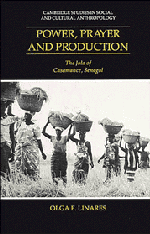Book contents
- Frontmatter
- Contents
- List of illustrations
- List of tables
- Acknowledgements
- Note on orthography
- INTRODUCTION: IDEOLOGY AND AGRARIAN CHANGE
- PART I THE POLITICAL ECONOMY OF SAMBUJAT
- PART II AT THE CROSSROADS: THE KUJAMAAT JOLA OF JIPALOM
- Chapter 3 Islamization and the introduction of a cash crop
- Chapter 4 The impact on social and productive relations
- Conclusions to Part II
- PART III MANDING MODELS AND FATIYA MORES
- EPILOGUE: THE JOLA IN THE PRESENT NATIONAL SCENE
- Notes
- References
- Index
- Cambridge Studies in Social and Cultural Anthropology
Conclusions to Part II
Published online by Cambridge University Press: 04 November 2009
- Frontmatter
- Contents
- List of illustrations
- List of tables
- Acknowledgements
- Note on orthography
- INTRODUCTION: IDEOLOGY AND AGRARIAN CHANGE
- PART I THE POLITICAL ECONOMY OF SAMBUJAT
- PART II AT THE CROSSROADS: THE KUJAMAAT JOLA OF JIPALOM
- Chapter 3 Islamization and the introduction of a cash crop
- Chapter 4 The impact on social and productive relations
- Conclusions to Part II
- PART III MANDING MODELS AND FATIYA MORES
- EPILOGUE: THE JOLA IN THE PRESENT NATIONAL SCENE
- Notes
- References
- Index
- Cambridge Studies in Social and Cultural Anthropology
Summary
Islam and groundnut production have had a disruptive effect upon the social organization of production in Jipalom. A community located in the Upper Baila basin, Jipalom is “typical” of the region north of the Casamance River known as Kajamutay. In all this area, the effects of Islam have been mostly indirect. By being historically and conceptually linked to the cultivation of groundnuts, Islam has augmented peoples' dependence on external markets. By eroding old beliefs and ritual practices, Islam has gradually contributed to the dissolution of productive relations. Until recently, a plurality of spirit-shrines underscored a coherent system of social action that brought co-resident men and women into relations of reciprocity and respect. Nowadays, the spirit-shrines bring mostly disease and misfortune. In the many years between my first and last visit to the area, neither a viable syncretism between old and new religious practices, nor a more vigorous form of Islam, have emerged.
The kinds of practices performed at life-crisis rituals, such as the prestations to the matrilateral kin, are crucial. Important usufructuary rights to land are secured by activating matrilateral ties. This applies particularly to usage rights over rice fields. Also, conflicts over land are traditionally mediated by the uterine kin of the compound, that is by the kusámpul. Today, the system is in flux. Islam is eroding the rituals that buttressed uterine relations, with the concomitant adverse effects on landuse patterns.
- Type
- Chapter
- Information
- Power, Prayer and ProductionThe Jola of Casamance, Senegal, pp. 140 - 144Publisher: Cambridge University PressPrint publication year: 1991

